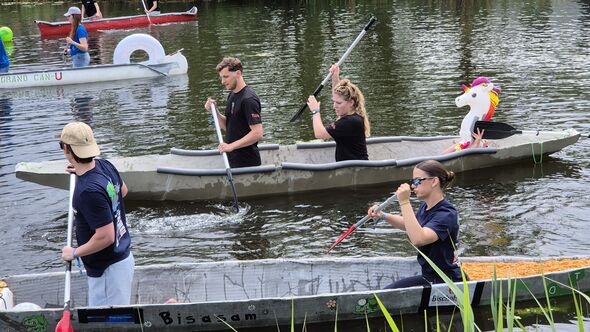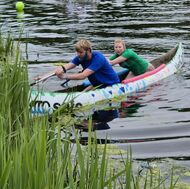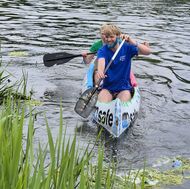A concrete canoe with moss? Why not!
At the annual concrete canoe race, one of the canoes was made using freshly picked moss and moss seeds. On Saturday, this canoe – along with 34 others – competed in various races of the Concrete Canoe Race held on the Eindhoven Canal near the Thêta boathouse. This year, the event was organized by the KOers association.
“Brake! Go! Turn only at the end!” It’s not for lack of encouragement from the – truly impartial – organizers that Renske and Irene, from the Structural Engineering and Design study association (KOers), fail to win the Women’s 200-meter heat around 2:30 PM on Saturday.
Because racing in a concrete canoe is not easy. KOers built the boat with a mold from a Canadian canoe, which makes it fast but very difficult to steer. This information comes from canoe builder and KOers chairman Joey in den Eng – an expert by experience. “With a team of fourteen, we’ve been working since September to build four canoes. One with a standard concrete mix, one with glass shards instead of sand and gravel, one with moss, and one made with the 3D concrete printer.” Unfortunately, the latter boat broke five days before the races. In den Eng saw it collapse like a Jenga tower when the construction committee tried to lift the canoe off the print bed in the lab at Vertigo.
A whole lot of questions come to mind. The two most fundamental ones: How is it possible for a canoe made of concrete to stay afloat? And why would you have races with them?
“It’s very easy to explain using Archimedes’ principle,” says In den Eng breezily. “Because of the shape of the canoe, we displace enough water. The buoyant force makes it float, no matter how heavy the boat.” The heaviest canoe in the 2025 competition weighs 480 kilos. “Because it’s possible.” But it doesn’t need to be that heavy. The lightest canoe (which wins a prize) weighs 28 kilos: it’s TU Dresden’s Carola Coaster. KOers’ canoes range from 120 to 240 kilos. The 3D-printed one would have weighed 110 kilos.
Concrete programs
The competitions are an annual inside joke among all the programs and companies involved with concrete. Besides TU Delft and Twente University, several universities of applied sciences (HBO) and senior secondary vocational education schools (MBO) also take part. It all started in 1977 in Delft, and the event is hosted in a different city each year. The last time it was held in Eindhoven was in 2018. Nowadays, German, Belgian and Swiss teams also compete.
Ruben Philips, KOers’ public relations commissioner, says that the lecturers from floor 9 of Vertigo are also highly involved. “They participate with their own self-built canoe, or they help out as commentators, referees or jury members.” On Friday night, all 35 canoes were weighed and measured in the lab on floor 0 (the canoes must be between 4 and 6 meters long and no more than 1 meter wide), and they were subjected to the sponge test. “No concrete should break off when a wet sponge is thrown at the canoe.”
Ruben Philips, KOers’ public relations commissioner, says that the lecturers from floor 9 of Vertigo are also highly involved. “They participate with their own self-built canoe, or they help out as commentators, referees or jury members.” On Friday night, all 35 canoes were weighed and measured in the lab on floor 0 (the canoes must be between 4 and 6 meters long and no more than 1 meter wide), and they were subjected to the sponge test. “No concrete should break off when a wet sponge is thrown at the canoe.”
Moss
It’s a shame that the 3D-printed canoe can’t compete, but it wouldn’t have been a world first for KOers anyway. A team from Switzerland and one from Utrecht had already done the same. What is innovative from the Eindhoven team is the concrete canoe with moss. Who comes up with such an idea?
“’What if we let moss grow on it,’ Sebastiaan of the ConCrew committee wondered,” says In den Eng. “The main reason was sustainability, but we also did it because it’s something new for us as a team. There’s some cautious interest in the construction world, but moss is still far from becoming standard practice. And for now, it’s also a bit more comfortable than just concrete when you’re in the canoe.”
“You should know that concrete is a mixture of cement, water, sand and gravel,” In den Eng continues. “This year, we replaced those last two with garden peat and vermiculite, a mineral that retains moisture. We covered that with fresh moss from Sebastiaan’s garden and moss seed, which you can just buy in stores.”
As he explains this, Michelle and Liisa win a heat in the women’s 200 meters, in the glass canoe. In that one, the sand and gravel were swapped out for shards of glass.
“Not all of the moss seeds sprouted,” says In den Eng with regret. “You can see a faint green haze. On the floor of the canoe is Sebastiaan’s moss, which felt nice on my knees this morning. I was in the canoe with my girlfriend and because we’re not exactly evenly matched in strength, the canoe veered sharply to the left. So a lot of water got in and now, the floor of the boat is basically a swamp.” Still, he stands by Sebastiaan’s idea of letting moss grow on a concrete canoe. “Maybe we started sowing too late. There’s a lot of room for improvement and I think we’ll keep developing this.”
One area of improvement may be the canoe training. KOers had offered this to its members, but it didn’t go ahead due to a lack of sign-ups. Many Eindhoven participants’ only experience was paddling in a plastic canoe. And for concrete canoe races, any canoeing skill comes in handy.
Postscript:
The canoes and participants of team Betonbrouwers from TU Twente and team OTH Regensburg dominated the distance races.
The sustainability prize ultimately wasn’t awarded because the jury felt that none of the canoes were sustainable.








Discussion